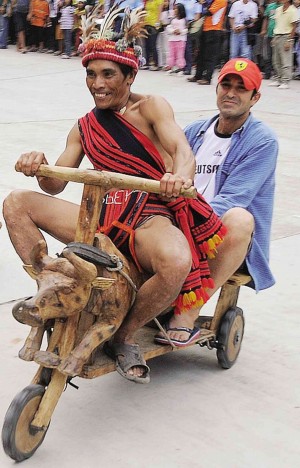
RIDING TANDEM A tourist experiences the thrill of a local ride as he hitches on a wooden scooter driven by an Ifugao man during the recent Imbayah Festival in Banaue town, Ifugao province.
EV ESPIRITU
Frequent summer visitors in the Cordillera may meet Nutnot Barnaba, clad in G-string, as he stands guard with a shield and spear over the best view of the Bay-yo rice terraces in Bontoc town, the capital of Mt. Province.
Barnaba is the custodian of a public toilet that serves tourists.
But like many Cordillera residents, he plays his part in keeping tourism alive as the festival season starts in the highlands during the summer break.
Ifugao province held its Imbayah festival last week, a thanksgiving feast held every three years.
Employees and clients of the telecommunications firm, Globe, are also set to travel to Tublay town in Benguet on mountain bikes as part of a campaign to raise money for a reforestation project of the Cordillera Conservation Trust (CCT).
The CCT has developed more than 50 seedling farms, mostly in elementary schools where pupils are taught about the value of the environment, said JP Alipio, CCT executive director, at a news conference on Tuesday.
Records from the National Statistical Coordination Board (NSCB) showed that 2008 recorded the highest number (1,117,226) of foreign visitors to upland destinations, like Sagada town in Mt. Province or Ifugao.
Foreign tourists, some of them young backpackers, numbered between 80,000 and 90,000 from 2007 to 2011, dropping to 77,193 visitors in 2012. But over a million local tourists visited the mountain communities in the same period, peaking in 2008 with 1,072,038 visitors and dropping to 830,223 in 2012, the NSCB said.
The rice terraces in Ifugao and Mt. Province are the most visited places in the Cordillera, although provinces like Apayao and Kalinga have been receiving their share of visitors lately, tourism officials said.
Tourism-related activities in the region have become lively because of newly paved roads and road projects scheduled in remote Cordillera towns.
Portions of the tourist town of Banaue in Ifugao were being paved when it was flooded with visitors who witnessed Imbayah’s performances and indigenous games last week.
The festival’s more popular feature was its races. Foreigners and residents lined the streets on Sunday to watch men in G-string speed down the zigzag roads in wooden scooters.
The scooters first drew attention in 2005 when residents decided to race these makeshift vehicles, which they put together using old wood and twine, much like the prototype used in the 1960s by a local official to ferry wood and crops.
The scooters have since become a marketable product, with Ifugao woodcarvers manufacturing what many consider moving sculptures.
In this year’s race, for example, Ifugao men rode on scooters styled like leaping tigers or galloping horses.
Robert Duyugen, 46, said he and the other woodcarvers from Banaue, had incorporated bicycle parts to control the scooters. Most of these scooters are made from “butbuta” (white wood) or “mananor” (red wood).
It takes a craftsman three days to create a simple wooden scooter, Duyugen said. Sculpted scooters take a week and sell for as much as P25,000.
The community developed a communal tree farm for scooter making, a side business arising from the robust tourist trade.